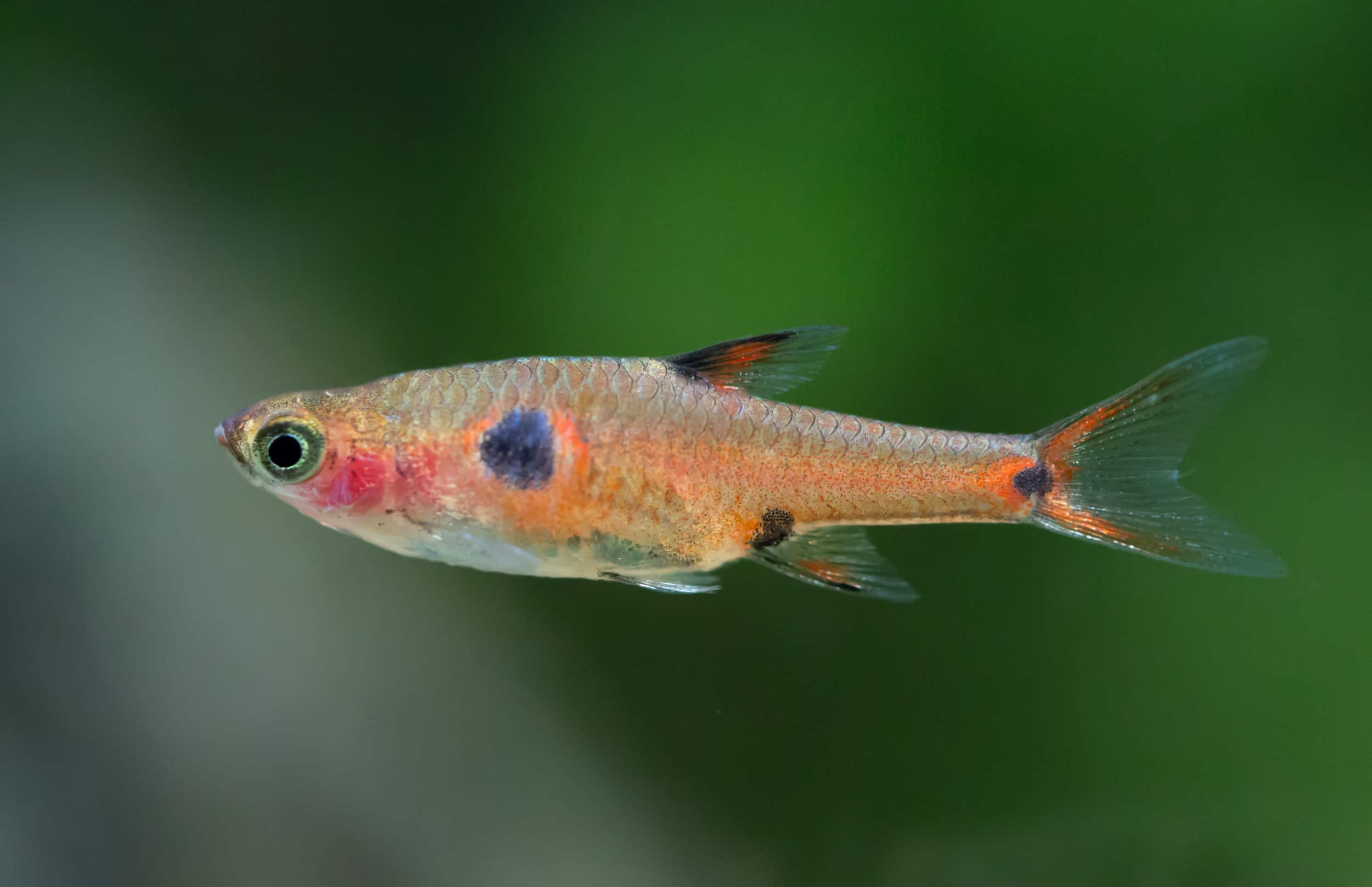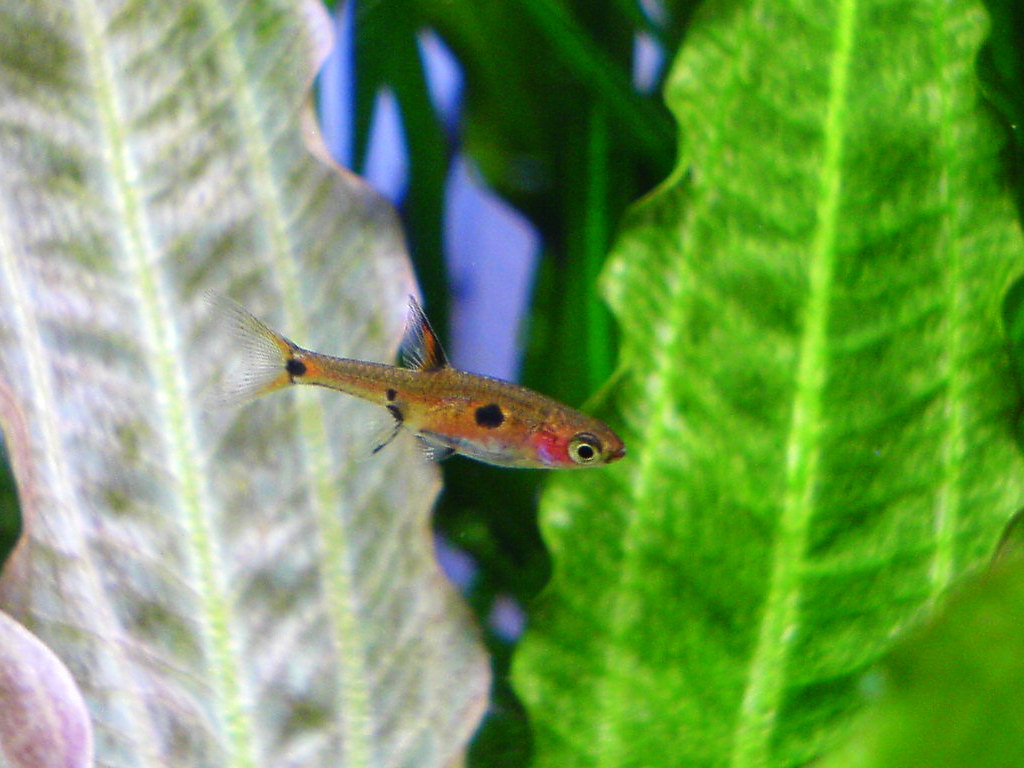Dwarf Rasbora
Lively with a distinctive glimmer, the Dwarf Rasbora – Boraras maculatus is an ideal selection for novice fish enthusiasts interested in maintaining smaller aquariums.
Marking a niche in the domain of smaller tanks, the Dwarf Rasbora is characterized by its appealing aesthetic and gregarious nature, making it an excellent specimen for both community and single species tanks.
- Experience Level: Beginner
- Hardiness: High level of care required when transporting
- Minimum Tank Size: 10 gal (40 L)
- Maximum Size: 1 inches (2.5 cm)
- Temperament: Peaceful
- Temperature: 75 – 80° F (24 – 27° C)
- pH Range: 5 – 6
- Water Hardness: 5 – 12 dGH
- Diet: Omnivore
Table of Contents
Introduction
Size and Appearance
Care Guide
Tank Mates
Diet and Feeding
Breeding
However, it’s worth noting that these fish, on account of their fragility, can be relatively tricky to obtain and transport, thus slightly more costly than other small tropical fishes.
Don’t let this discourage you however, from embracing the moderately challenging yet rewarding experience of raising Dwarf Rasboras. A school of these in your aquarium adds a unique addition to a community tank.
Size and Appearance
The dwarf Rasbora, with its notable petite size of less than three quarters of an inch, falls under the category of Pygmy Rasboras and is renowned for its vibrant, gleaming hues. This micro rasbora is commonly found scattered from Southern Malaysia to Thailand, Sumatra, Singapore, and Indonesia, making its home in various bodies of water such as streams, ponds, bogs, and ditches, typically near forest regions. The ideal habitat for these small schooling fish is lazy, tannin-tinted, murky waters filled with abundant plant life and a muddy bottom.
Dwarf rasboras, being micropredators, feed on tiny insects, worms, and zooplankton. They exhibit an overall rosy body tone sprinkled with an array of colorful patches, usually red or orange, situated behind their eyes. Interestingly, these patches can vary in color between individuals. Furthermore, most fish flaunt a distinguishable black spot at the center of their bodies with smaller spots found towards their anal fin and tail. The males are characterized by more flamboyant colors and a slender shape, whereas the females are generally pinker and fuller in shape.
Care Guide
- Minimum Tank Size: 10 gal (40 L)
- pH Range: 5 – 6
- Water Hardness: 5 – 12 dGH
- Temperature: 75 – 80° F (24 – 27° C)
- Lighting: Moderate, diffused lighting
- Substrate: Fine sand/gravel
- Brackish: No
- Water Flow: Weak/Low
- Tank Region: All areas
Known by the alternate name pygmy spotted rasbora, this particular species calls for careful maintenance due to its sensitivity to water conditions. The water in their endemic freshwater habitats may appear dark but is incredibly clean. As such, similar pristine conditions need to be emulated in their tank. It’s essential to note that Dwarf Rasboras may not react well to fish medicine, underpinning the importance of proactive prevention for disease avoidance.
The Dwarf Rasbora is a comfortable inhabitant of smaller tanks, with a school of 10 individuals being suitable for a five-gallon aquarium. However, ideally, these fish should be housed in larger tanks of up to 20 gallons, particularly when hosting other tankmates and engaging in aquascaping. Ensuring stability in water conditions is paramount for tropical fish, especially for this species. The best way to achieve this is by installing a top-notch filtration system, such as an external canister, which does not get clogged with substrate debris coupled with a mild water return.
The water’s pH, dH, and temperature must fall within the preferred range to prevent the fish from becoming sick or dying prematurely. Therefore, it’s vital to regularly check the water quality, every few days or when something appears off in the aquarium. Given the variation in local climates, an aquarium heater may be required to maintain the optimal temperature range of 75 to 80 F (24 – 27 C).
Remember, sustaining the right pH, dH, and temperature range is just as critical as maintaining the cleanliness of the water for the survival and health of these species. Routine cleanings should be weekly, at a minimum. Dwarf Rasbora is susceptible to most of the common tropical freshwater fish diseases, including Ich, skin parasites, and swim bladder disease.
Should you notice the first signs of disease, it’s advisable to immediately remove the diseased fish from the main tank as illnesses can spread rapidly among rasboras. While treating them in a separate tank using common medications can be attempted, please note that this species tends not to respond well. Often, prevention trumps cure in their maintenance.
Adding Dwarf Rasboras to your aquarium may be slightly tricky, as they can be easily disturbed by fluctuations in water quality. Hence, it’s recommended to acclimatize them by mixing some destination tank water with the transport water before transferring them to the aquarium. A substrate comprising standard aquarium sand or fine gravel is ideal. Using a dark substrate would mimic their native environment, allowing their bright colors to truly shine.
Dwarf Rasboras thrive in peat-stained water – supplementing with peat bags or other peat alternatives can enhance their vitality. Some aquarium keepers also add aquarium-safe peat directly to their tanks. Once soaked and heavy, the peat settles at the bottom and gradually biodegrades. Dried leaves from trees such as oak or beech can also serve as part of the substrate. When these leaves degrade, they give birth to microbes, providing a source of nutrition for the Dwarf Rasbora fry.
Properly maintained stained water will enable their vibrant colors to truly pop. A neglect of this aspect can leave you with visually lackluster fish. In setting up the aquarium, it’s beneficial to position plants along the back and sides, leaving ample space for the Dwarf Rasboras to swim freely. Suitable plants include species like guppy grass, which can be both rooted and floating. Using floating plants can also curb their leaping tendency. They also have a preference for thick matted plants like Java moss as they provide both food and shelter for the Dwarf Rasbora fry. You can also add structures such as oak or beach driftwood to recreate the appearance of their native habitat and enhance the tannic quality of the water. Rocks and other such structures can be included to provide shelter for the tank mates.
Tank Mates
Friendly and unimposing, Dwarf Rasboras are an excellent choice for inhabitants of warm water or tannic, dark waters. For this reason, they can share tanks with an assortment of schooling and bottom-dwelling species. It’s recommended to choose peaceful species for tankmates that aren’t large enough to pose a threat of ingestion to the Dwarf Rasbora.
Rosy Tetra: Rosy Tetras, and several other variants, do well in similar water conditions. They are generally peaceful, though they might indulge in fin nipping in stressful or overcrowded conditions.
Guppy: There are numerous Guppy variations that make for great tankmates. All Guppy varieties are peaceful and interact harmoniously with any species that don’t threaten to eat them.
Plecos: Plecos are stunning bottom-dwellers renowned for their contribution to the cleanliness of an aquarium. These omnivorous creatures are peaceful, although they prefer being solitary, so it’s advised to limit aquariums of standard size to one Pleco.
Corydoras: Much like Plecos, Corydoras are a type of bottom-feeding catfish that are often found in tropical freshwater tanks. Growing up to 4 inches in size, they are omnivorous and peaceful in nature.
Cardinal Tetra: Cardinal Tetras are good neighbors to many similarly docile fish. A school of Cardinal Tetras adds elegance to any fish tank, always an excellent choice. It’s best to add them in groups of 10.
Neon Tetra: Perfect tank mates. Adding them in groups of 10, parallel to the Cardinal Tetras, for every 20 gallons will create a dynamic and shimmering display.
Green Neon Tetra: If you are aiming to maintain a vivid aquarium, the Green Neon Tetra is a great tank mate. This fish, similar in size and look to Neon Tetras, carries a captivating neon green stripe on its sides.
Shrimp: Several species of small freshwater shrimp are compatible tank mates for Dwarf Rasboras.
Snails: Snails are slow-moving and peaceful creatures that contribute to the cleanliness of the aquarium.
Fish larger than two inches in length: Fish of this size have the potential to feed on or harm the small, timid Dwarf Rasbora.
Semi-aggressive or aggressive species: Species like Cichlids and Danios are territorial by nature and could prey on small fish such as the Dwarf Rasboras.
Feeding Guide
- Diet: Omnivore
- Frequency: Several small feedings per day
- Pellet Foods: Yes
- Flake Foods: Yes
- Live Foods: Yes
- Meat Foods: Yes
- Vegetable Foods: Yes
In their natural habitat, Dwarf Rasbora feed on small invertebrates, insect larvae, minute worms, algae, and zooplankton. When in captivity, they should be given a balanced diet that includes both plant-based and meaty foods. Moreover, due to their diminutive size, they require food items that are proportionately small. Some suitable food sources include:
• Artemia
• Baby brine shrimp
• Cyclop-eeze
• Daphnia
• Miniature flakes or tablets
Breeding
Breeding Dwarf Rasboras is not as straightforward as other species; however, it’s entirely possible with some effort. Dwarf Rasboras are continuous spawners and scatter their eggs around without guarding them once laid. Therefore, if you’re keen on breeding, the only requirement, apart from housing them in a well-kept tank, is to have a mix of male and female fish. For increasing chances of breeding success, consider setting up a separate breeding aquarium for raising the fry.
The breeding tanks for Dwarf Rasboras can function within a mild set-up. A five-gallon aquarium with standard water filtration suffices as a breeding space, equipped with the necessary heating equipment to maintain the water temperature between 75F and 80F. The water pH should range between 5.0-6.5. You can further enhance the breeding environment by adding a dark substrate and tannins to darken the water.
You might want to incorporate Java moss at the base or a mat for the eggs to drop into, preventing the adults from consuming them. Products such as grass mats or astroturf are effective for this purpose, covering up to half of the base of the tank.
Once the breeding environment is set up, a pair or two of Dwarf Rasboras may be introduced. Monitor the fish during the acclimatization process to check for any signs of stress or shock. Indicators of successful reproduction include territorial displays by the male fish and the scattering of eggs on the bottom. This might also transition to the appearance of tiny fry in the tank.
Given successful acclimatization, reproduction should begin within a day or two, spanning over two to three days. Subsequently, the fish can be moved back to their home tanks.
Provided that the fish have laid fertilized eggs, these eggs should hatch within 24 hours of spawning. Fry are presumably small and live off their yolk sacs for approximately 24 hours. During that time, prepare to feed them microscopic food items such as green water or paramecium.
After approximately a week or 10 days, the fry will grow to accommodate larger food sources such as brine shrimp nauplii and microworms. Additional fry may continue to appear a few days following this. It’s preferable to postpone water changes until at least a week after all fry have hatched to avoid shocking or harming the young fish.
Within a month, the fry will reach their mature size. Successfully breeding and maintaining healthy Dwarf Rasboras can uncover opportunities for localized selling and trade, given their sensitivity to changes in water and transportation stress.



